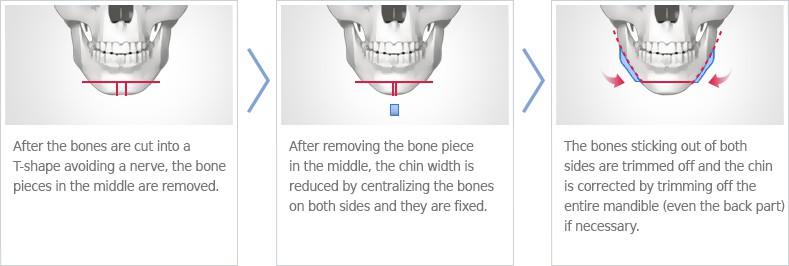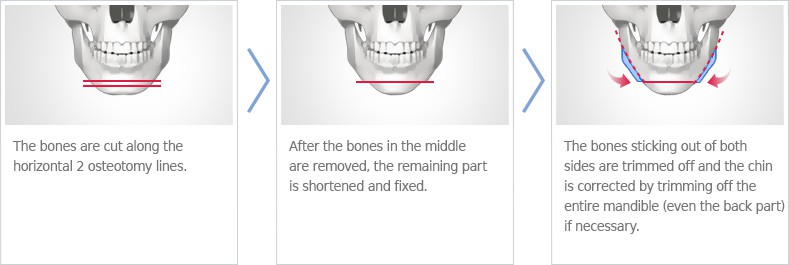
Jaw Reduction
Soften angular jaws. Achieve slimmer v-line.

Procedure Time
2 – 3 Hours

Anaesthesia
General Anaesthesia

Recovery Period
14 – 18 Days

Stitch Removal
7 Days Post-op
What Is Jaw Reduction Surgery?
Jaw reduction surgery is often recommended for jaw slimming. A broad lower jaw or squarish jaw if often associated with masculinity and can make the face look big and wide which is not a popular beauty trait among Asians. The procedure focuses on making the jaw and chin slimmer by reducing the bulk and prominent angles to attain a smaller and more beautiful v-line.

Who Is Suitable For Jaw Reduction Surgery?

Jaw reduction surgery is recommended for people with the following concerns:
- Wide and angular jaw
- A male-like appearance due to the shape of the lower jaw
- Those with jaws which are parallel or wider than the top half of the face
- A long or squarish chin
- Asymmetrical jaw or chin
What Are The Types Of Jaw Reduction Surgical Methods?
1. Mandibular Resection- The Lower Jaw Surgery Angle Cutting
The part of the lower jaw under the ear is called an angle. The extra bone at the angle area gives a square shape to face. In this surgery, the angle is removed and a smooth V- line is achieved.
2. The Cortical Resection- The Lower Jaw Angle Shaving
Again, the area for removal of bone is still the angle of the jaw. The difference with the previous procedure is that in cortical resection, only the outer layer of bone is removed. This reduces the width of the jawbone to create a slimming effect on the v-line.


3. The T-Osteotomy
In cases where the chin is broad, sections of the jaw bone will be reduced and reshaped to achieve the desired V-line.
The two vertical parallel cuts are made in the midline and a little distance apart on the chin with one horizontal cut above them.
The middle bone portion between two parallel vertical bone is removed and two side segments are joined. The rest of the mandible from sides is reshaped to achieve the desired V-line feminine shape.

4. V- Osteotom
In the case of a very broad jaw, this technique will be recommended. Two inverted V cuts are made in the midline of the chin. The middle portion of the bone between the two “Vs” is removed and sides of the jaws are reshaped.

5. Horizontal Osteotomy
This is performed for elongated chin and wider jaw.
Two horizontal parallel cuts are made on the chin. The distance between cuts decides how much bone will be removed. The segment between upper and lower chin is removed and the lower segment is attached to the chin. The excess bones are removed to create a smooth jawline.

Frequently Asked Questions (FAQ) about Jaw Reduction Surgery
What Is Aftercare Like After Jaw Reduction Surgery?
Proper care is important after Jaw Reduction surgery to avoid infection while accelerating recovery at the same time. You’ll get a complete guide from your surgeon to help with postoperative recovery, which most likely includes the following recommendations:
- Try to keep the face in an elevated position as much as you can, even when asleep. Keeping your face elevated will help reduce swelling significantly.
- Patients should move around in the home or take short walks as they start feeling more comfortable. Such movement encourages blood circulation and helps with the healing process.
- Keep yourself on a liquid diet after the surgery for one week, at least. Drinking food, instead of chewing it, helps avoid trauma to your jaw area and the surgery site, making it less painful. Patients should only consume hard foods around one month after their jaw reduction surgery.
- It may be necessary for the patients to wear a compression bandage on their face. They are encouraged to wear such bandage all the time for the first week after undergoing the procedure. After that, they should wear it when at home and even while sleeping.
- It is recommended to regularly use an antibacterial mouth rinse for keeping your mouth as well as the site of the incision clean. It will help avoid infection.
- Try not to indulge in strenuous activities. Avoid heavy lifting for, at least, a month after the procedure.
- Don’t smoke or consume alcohol for a couple of weeks after the jaw reduction procedure.
- Visit your surgeon for follow-up appointments. The surgeon will check on the recovery progress while also allowing you to voice your concerns or ask any questions.
Patients can generally get back their normal social life and work routine in around 14-18 days of their jaw reduction surgery. Some swelling can still exist by then and it will continue to subside over time.
When Will I Expect To See The Results Of The Surgery?
Patients can expect permanent results after a jaw reduction surgery. It is common to experience noticeable swelling after the procedure and, therefore, it can take a few days to a week to be able to remove the compression bandage. The results will be prominent as soon as you can remove the bandage. Sometimes, it may take a few months for all the swelling to subside.
The new jawline contours will become evident after the swelling goes away. If any changes are noticed in the jawline as it heals, or there is unusual pain, talk to your surgeon about it in the follow-up appointment.
Will My Skin Adapt To The New Shape Of My Jaw?
In younger patients who have good skin elasticity, the skin generally adjusts to the newly formed jawline. When it comes to older patients, however, the re-adaptation of the skin to the new jawline isn’t always that straightforward. They may even experience some skin sagging issues. Both invasive and non-invasive procedures are available to address any skin laxity concerns after surgery.
Can The Jaw Bone Grow Back Once It Has Been Cut Or Shaved Down?
No, the growth of jaw bone is not possible after the procedure. However, the masseter muscle that is present along your jaw can become thicker when you clench and grind repetitively.
After Jaw Shaving, Can Dental Implants Still Be Inserted?
The bone removed during the procedure is taken from your jaw’s lower edge, away from your teeth. So, the surgery doesn’t impact the dental work that might be needed at all.
Do I Need To Be Hospitalized After Jaw Reduction Surgery?
Most of the time, the procedure is termed as a day surgery procedure which means that the patients don’t need to get hospitalized after the surgery. They can return home the same day after undergoing surgery. It is advised, however, that somebody should be there to take care of the patients, at least, for the first 2-3 days after surgery if they are staying alone. When the case is more complex, however, your surgeon may recommend you to get hospitalized for 1-2 days. This differs from one case to another.
